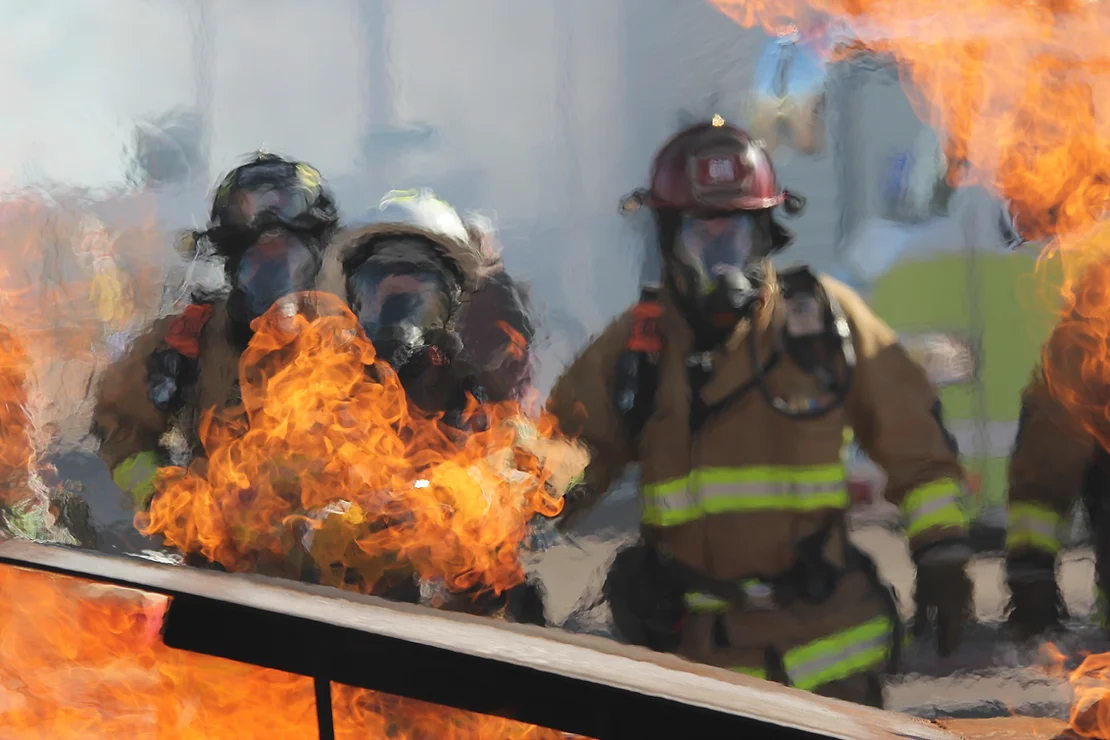When a person works in a hot environment, the body must get rid of excess heat to maintain a stable internal temperature. It does this mainly through circulating blood to the skin and through sweating. When the air temperature is close to or warmer than normal body temperature, cooling of the body becomes more difficult. Blood circulated to the skin cannot lose its heat. Sweating then becomes the main way the body cools off. But sweating is effective only if the humidity level is low enough to allow evaporation, and if the fluids and salts that are lost are adequately replaced.
If the body cannot get rid of excess heat, it will store that excess heat. When this happens, symptoms of heat illness start to develop. The body’s core temperature rises and the heart rate increases. As the body continues to store heat, a person begins to lose concentration and has difficulty focusing on a task, may become irritable or sick, and often loses the desire to drink. The next stage is most often fainting and even death if the person is not cooled down.
Excessive workplace exposure to heat can cause a range of heat-related illnesses, from heat rash and heat cramps to heat exhaustion and heat stroke. Heat stroke can result in death and requires immediate medical attention.
Determining Unsafe Working Conditions
Working conditions may become dangerous if the temperature rises and/or humidity increases to the point that the heat index is at an unsafe level.
The heat index indicates how hot it really feels when relative humidity is factored with the actual air temperature. The heat index is a better measure than air temperature alone for estimating the risk to workers from environmental heat sources. This information can help workers and employers take precautions in a timely way to prevent heat-related illness.
Jobs that Expose Workers to Heat
Many workers are exposed to heat on the job, either outdoors or in hot indoor environments. Indoor workplaces with these conditions may include iron and steel foundries, brick-firing and ceramic plants, glass products facilities, rubber products factories, electrical utilities (particularly boiler rooms), bakeries, confectioneries, commercial kitchens, laundries, food canneries, chemical plants, mining sites, smelters, and steam tunnels.
Outdoor operations conducted in hot weather and direct sun, such as farm work, construction, oil and gas well operations, asbestos removal, landscaping, emergency response operations, and hazardous waste site activities, also increase the risk of heat-related illness in exposed workers.
Workers exposed to hot indoor environments or hot and humid conditions outdoors are at risk of heat-related illness, especially those performing jobs that involve significant physical exertion or jobs that use bulky or non-breathable protective clothing and equipment.
Environmental factors that put workers at greater risk of heat-related illness include exposure to radiant heat sources, contact with hot objects, direct sun exposure with no shade, and limited air movement (no breeze, wind, or ventilation).
Some workers might be at greater risk than others if they have not built up a tolerance to hot conditions, or if they have certain health conditions. Workers who are suddenly exposed to working in a hot environment face additional, but generally avoidable hazards to their safety and health. New workers and those returning from time away are especially vulnerable.
Prevention Techniques
Heat-related illnesses can be prevented through implementing engineering controls, proper work practices, and worker training. This section provides employers with information about safety measures, equipment, and work practices that employers can use to prevent heat stress and heat-related illnesses in the workplace. This section also outlines how employers can provide training to workers so they understand what heat stress is, how it affects their health and safety, and how it can be prevented.
Engineering Controls
The best way to prevent heat-related illness is to make the work environment cooler. Implementing proper engineering controls, such as adequate air conditioning and ventilation, can make the work environment cooler. Engineering controls include:
- Air conditioning (such as air-conditioned crane or construction equipment cabs, and air conditioning in break rooms).
- Increased general ventilation.
- Cooling fans.
- Local exhaust ventilation at points of high heat production or moisture (such as exhaust hoods in laundry rooms).
- Reflective shields to redirect radiant heat.
- Insulation of hot surfaces (such as furnace walls).
- Elimination of steam leaks.
Work Practices
Developing work practices such as work/rest cycles, drinking water often, and providing an opportunity for workers to build up a level of tolerance to working in the heat, is critical to preventing heat-related illness. Specific work practices that can be implemented include:
- An emergency plan that specifies what to do if a worker has signs of heat-related illness, and makes sure that medical services are available if needed.
- Steps to help workers become acclimatized (gradually building up exposure to heat), especially workers who are new to working in the heat or have been away from work for a week or more.
- Note: The U.S. Occupational Safety and Health Administration (OSHA) advises employers to gradually increase workloads and allow more frequent breaks during the first week of work. OSHA advises employers to closely supervise new employees for the first 14 days, until they are fully acclimatized.
- Providing for adequate, portable (safe for drinking) water close to the work area, and encouraging employees to drink small amounts of water frequently.
- Permitting workers, whenever possible, to distribute the workload evenly over the day and incorporate work/rest cycles, so that workers are not exposed to heat for extended periods of time.
- Reducing physical demands during hot weather, if possible, or scheduling heavier work for cooler times of the day.
- Rotating job functions among workers to help minimize overexertion and heat exposure.
Worker Training
Employers should implement worksite training and plans that educate workers about the dangers of heat. Workers and supervisors should be trained about the hazards and prevention of heat exposure. Topics should include:
- Risk factors for heat-related illness.
- Note: Workers at greater risk of heat stress include those who are 65 years of age or older, are overweight, have heart disease or high blood pressure, or take medications that may be affected by extreme heat.
- Different types of heat-related illness, including how to recognize common signs and symptoms.
- Heat-related illness prevention procedures.
- Importance of drinking small quantities of water often.
- Importance of acclimatization, how it is developed, and how your worksite procedures address it.
- Importance of immediately reporting signs or symptoms of heat-related illness to the supervisor.
- Procedures for responding to possible heat-related illness.
- Procedures to follow when contacting emergency medical services.
- Procedures to ensure that clear and precise directions to the worksite will be provided to emergency medical services.
- Training as to appropriate personal protective equipment (PPE) that can be used to prevent heat illness. In some workplaces, insulated gloves, insulated suits, reflective clothing, or infrared reflecting face shields may be needed. Thermally conditioned clothing might be used for extremely hot conditions; for example:
- A garment with a self-contained air conditioner in a backpack.
- A garment with a compressed air source that feeds cool air through a vortex tube.
- A plastic jacket whose pockets can be filled with dry ice or containers of ice.







